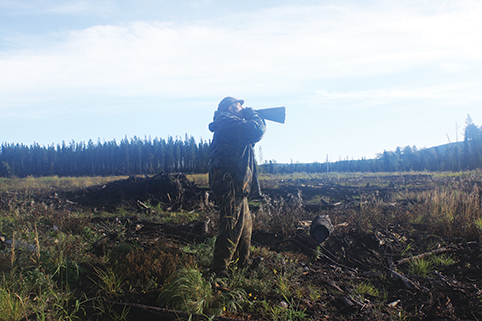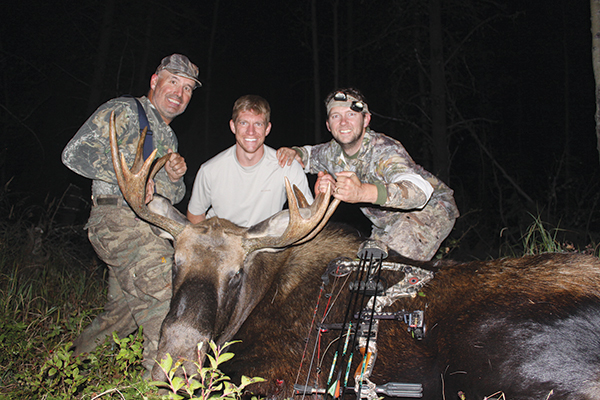 Wilderness Adventure: Calling Alberta Bull Moose
Wilderness Adventure: Calling Alberta Bull Moose
By Toby Walrath

The distant bull grunted for a third time and then slammed heavy antler against a tree trunk, making that distinctive thud. It was my first trip to Alberta, Canada, and the weather was warmer and sunnier than I expected in early September. My friend Curtis was on his first moose hunt anywhere. I had bid for the hunt at the Montana Bow Hunters Association Convention, and we were hunting with an outfitter, something required by provincial law that we’re not accustomed to doing.
Zane, the outfitter, was proving to be an excellent guide. The moose numbers in his area were better than we’d hoped. Tracks and scat littered the logging roads everywhere we went.
Curtis attempted to stalk the rutting bull we heard during the last few minutes of legal shooting light, and I hung back to glass the vast logged areas. Brush and stumps pushed into huge mounds by loggers offered good cover, albeit the sight lines were cut short by obstacles as big as the bulldozers that had created them.
As I sat leaning against a stump, a young bull and three cows emerged from the edge of the timber and fed their way toward me. Another bigger bull moved slowly across a clear-cut area, intent on keeping the younger Bullwinkle on the fringes. I tried to sneak in for a shot, but with so much debris in the way and the light fading, it wasn’t meant to be. Rather than risk spooking the moose, I circled back to my companions.
When Curtis, Zane and I reunited, I learned that Curtis had not been able to locate the bull we had heard. But we all agreed it had been a great start to the week.
Being from western Montana and witnessing local moose numbers plummet in recent years, it was reassuring to know that Alberta still held plenty of moose. I already had seen more than I would expect to see during the entire three-month big-game season back home.
The habitat is choice for moose. Logging operations leave clear-cut areas that are burned in winter to simulate natural forest fires, and that spurs fresh growth in the spring. Straight roadways stretching to the horizon remain long after the natural gas exploration efforts end, creating even more edge cover.
In Alberta, it is illegal to use a motorized vehicle between sunrise and noon while hunting, so getting out of camp in time to get to the hunting location required a very early wake-up call. Zane was up and had coffee percolating and lunch packed long before daylight, and after a quick bowl of oatmeal, we were loading the truck.
Zane’s thick Alberta accent took some getting used to, but it wasn’t long before I caught myself saying “meters” instead of “yards,” and “the bush” instead of “timber” to describe thick areas adjacent to the cut lines. He didn’t get many bowhunters in camp and was taking it as a challenge.
Zane is a true woodsman, willing to work hard on another hunter’s behalf.
At each location Zane would call sporadically for an hour or so. If nothing responded, we moved to a new location. Mid-afternoon we enjoyed a hot lunch and then glassed open areas until a couple of hours before dark. The remaining hours were spent calling and listening for a response from a bull moose.
Zane’s calling varied from a grunt every 15 minutes to a series of moans and long silences lasting 30 to 40 minutes. He carried a real moose antler, a handmade birch bark horn, and a Montana Decoy everywhere we went. He also sprayed moose estrus at each stand.
Zane raked trees and snapped branches, never just making a single call. He explained that a variety of calling sounds and patience are the keys to success during early September. His ability to “guess” where the moose would be is something only people who spend a lifetime in the northwoods possess.
When Zane learned that I had successfully called and hunted moose in both Montana and Idaho, he cut the bark from a white birch tree, rolled it into a cone, wrapped electrical tape around the narrow end and handed me my very own birch bark horn.
He said the horn would carry the sound better than my voice alone and make a more authentic call; I had to admit the sound did carry loud and clear. We worked in tandem with a variety of grunts and moans to simulate lovesick moose searching for one another. Cow calls are short, loud bursts of estrus moans in contrast to the call of a rutting bull, which echoes with a low dull “mugh … mugh.”
Since Curtis had never tagged a moose, I wanted him to have the first shot and we concentrated on trying to tag-team call a moose into Curtis’s position.
The fourth evening we sat for over an hour not far from where I had seen that first moose of the trip. The two-track skidder road we sat beside meandered through thick bush ending at the edge of a clear-cut. Curtis sat to my left with Zane about 40 yards in front of us.
With maybe 10 minutes of shooting light left, I decided to walk a short distance and glass an open clear-cut, hoping that once I got my head above a short hill I might be able to hear or see a moose feeding in the open. Just as I peered over the hill with binoculars in hand, Zane waved Curtis over. I heard one bull grunt about 200 yards away and then another. With the sun dropping below the horizon there wasn’t much time to think as a third bull joined the chorus.
Curtis got into position as a bull circled downwind. His range finder read 120 yards as he tracked a bull that was moving closer. The next reading on the display was 68 yards—and still closing. Another bull picked up Zane’s scent, turned and trotted away on a path that angled toward Curtis. He marked a tree at 48 yards, raised the bow and waited.
As the bull passed the tree and came even closer, Curtis cut loose with a loud “Mugh!”
The bull stopped, and Curtis pulled the trigger on his release. Everything happened so fast he wasn’t sure of the hit, even though he had practiced the 40-yard shot a thousand times.
“OK,” Curtis said when he got back to Zane and me. “I think I got him.”
I could hear the bull coughing inside the timber at less than 100 yards. “He’s not going far,” I said.
“Don’t jinx me, man!” Curtis cried out. Apparently, Curtis was more superstitious than I realized. But when I hear a bull making noise 50 yards from where someone just shot it, I figure that moose isn’t going far.
We walked a mile or so back to the ranger and climbed in. The walk back in the dark had provided ample time to prepare mentally for the second hunt—the blood trailing. When we got back the beam from my headlamp soon illuminated a leaf soaked with bright, frothy blood. “That’s lung blood,” I said. “You got him.”
Curtis shot me a glance.
There was blood every 3 feet right up to the arrow that lay on the ground. It, too, was soaked in frothy blood. Ten steps beyond that, the eye of the bull glowed brightly in the light beam.
“That’s an eyeball!” Curtis yelled and ran to claim his first moose.
“I just shot a moose!” he exclaimed, all doubt finally erased. “With a stick!”
It was by far the biggest animal he had taken with a bow, and at 35 inches wide, the rack was well worth celebrating. Zane said a silent prayer, something he always does to honor the animals taken.
Such respect added a fine element to a special moment for all of us.
Zane decided to drive back to camp to get another guide to help with the work. We took the tarps and saws from the utility vehicle, carried them to the moose and laid it all out along with pack frames, rope and knives. Zane congratulated Curtis again and said he would be back as soon as he could round up the help.
Curtis and I consider field care an integral part of the hunting experience, one that we wouldn’t want to give up regardless of the situation. We didn’t care that most people on guided hunts don’t quarter, cape, and load their own moose. And the idea of being able to drive a ranger right up to load the quarters was as foreign to us as the Canadian bush.
We had the quarters stacked on tarps beside the logging road when Zane came back with the other guide. “There’s nothing left to do!” Zane declared.
Curtis and I are used to handling our own game and had left only the ribs and the head back at the kill site. As we were throwing the final quarter onto the back of the ranger, Zane told his cohort: “That’s how these Montana boys do it!”
The days that followed were spent hiking, calling and exploring new country. I have been a trapper since childhood, always fascinated by tracks and wildlife. I tend to get especially distracted by lynx and fisher tracks. Zane would point out anything of interest as we moved about. I asked to visit one of the trapper cabins commonly found on Alberta’s registered traplines, which for me was a highlight in itself. There is no such thing as a trapper’s cabin on public land in Montana.
Curtis came along when he wasn’t tending his moose meat and hide, which was being kept in a freezer about an hour’s drive from camp.
Over the next few days I heard coyotes howl and saw fisher running through the forest. The amount of fisher sign astounded me. The statewide quota in Montana is five. Lynx tracks also seemed to be everywhere—right alongside wolf, bear and mountain lion, which Montana does have in abundance.
Zane and I called two big bulls to within 100 yards on my final morning, but I wasn’t able to get close enough for a shot. In all we called eight bulls to within 100 yards during a six-day hunt. This earned Zane the nickname “Moose Ninja.”
The rolling hills, thick forest and boggy bottomland near the little logging town of Edson, Alberta, make for a great moose hunting locale.
While I didn’t bring a moose home Curtis did, and the experiences I shared with an old friend while making a new friend sealed the deal for me.

* * *
Silver Fox Outfitters (780)-723-3598; www.silverfoxoutfitters.com